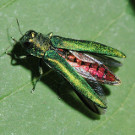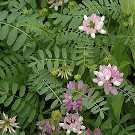7–9 minute read
Routine Care
fertilizing
Do not fertilize perennials, woody plants or subshrubs. Fertilizing now stimulates new growth that will not harden off properly in the fall, increasing the likelihood of frost and freeze damage.
mulching
- Mulch new plantings to a depth of about 1 inch, keeping it away from plant crowns, to conserve moisture and suppress weeds. Deeper mulch can cause drought stress to new plants because the mulch intercepts water meant for the roots. This is especially important here because the only rain we get in the fall is from hurricanes. Otherwise, it is very dry.
- Wait to mulch established plants until early winter after a hard freeze. Because mulch traps heat, heavy mulching in fall is counterproductive. It prevents plants from entering dormancy properly and thus increases susceptibility to winter damage.
- Don’t mulch established peonies. Peonies require a minimum number of chill hours in order to bloom and mulch can keep the crown too warm.
Find the best mulch for your situation
How to apply mulch
tidying
Remove all fallen rose leaves to prevent reinfection with blackspot and other fungi.
watering
Reduce watering somewhat to encourage plants to prepare for dormancy. A little water stress enhances fall color on many trees and shrubs. However, be sure to water foliage plants and plants that will produce flowers or berries in the fall or winter.
houseplants
Prepare house plants to reenter your home. Remember, temperatures of 45°F can damage many tropical house plants.
- Check plants carefully for insects and/or disease. Wash leaves thoroughly and soak the soil in a bucket of water for 3–5 minutes to encourage any insects hiding in the soil to emerge.
- Trim any dead or weak foliage, but wait until spring to repot.
Special tasks
bulbs
- Fertilize spring-flowering bulbs at planting time with a balanced fertilizer. Bonemeal is not necessary.
- Dig and store summer bulbs like gladioli, dahlias (hardier cultivars can overwinter in the ground in protected locations), and caladiums before frost.
Fall-flowering Bulbs: Colchicum, Crocus and Cyclamen
Summer and fall flowering bulbs for the landscape
The myth of beneficial bonemeal
planting & Propagating
Fall is the ideal time to plant and transplant most species. It is also the best time to divide hardy spring- or summer-blooming perennials like iris, daylilies and peonies. Warm soil and cool air let plants focus energy on roots rather than foliage, and because our soil stays warm enough for root growth almost year-round, roots can establish before the heat and drought stress of summer. Although this is the best time of year to move most plants, keep in mind that dry soil is often a problem. Historically, fall is extremely dry unless a hurricane brings rain. Be sure to provide an inch of water weekly if rain fails.
Detailed instructions for all aspects of planting
- Shop for plants early because most retailers do not restock once a plant has sold out.
- Plants experience less stress if moved when the air temperature is cool. Deciduous plants are happiest if installed once the leaves have fallen.
- Wait until spring to plant, transplant or divide tender perennials, most fall-blooming perennials and ornamental grasses, and species that require a full growing season to develop a good root system. Examples are butterfly bushes, tap-rooted plants like baptisias and hybrid purple coneflowers, and slow-growing, fleshy-rooted evergreens like magnolias and camellias. It is fine to plant pansies and chrysanthemums.
- Root-prune any woody plants that you plan to move next spring.
pruning
| Jan | Feb | Mar | Apr | May | Jun | Jul | Aug | ||||||||||
|---|---|---|---|---|---|---|---|---|---|---|---|---|---|---|---|---|---|
| TREES | |||||||||||||||||
| shade | |||||||||||||||||
| bleeder | small branches | ||||||||||||||||
| fruit | |||||||||||||||||
| SHRUBS | |||||||||||||||||
| summer-blooming | after bloom | ||||||||||||||||
| spring-blooming | after bloom | ||||||||||||||||
| broadleaf EG | dieback | ||||||||||||||||
| needle EG | |||||||||||||||||
| HERBACEOUS | |||||||||||||||||
| grasses | |||||||||||||||||
| flowers | pinch, deadhead | ||||||||||||||||
Do not prune. Pruning now will promote tender new growth that cannot survive the cold.
soil Test
It is a good idea to test your soil every 2–3 years so that you can adjust pH and fertilize more accurately. Testing is free from April–November. You can pick up and drop off soil boxes, forms, and sampling instructions 8am–5pm M–F in the lobby of the Extension Office: Bonnie B Davis Center, 1020 US-70W.
Learn more about soil testing
problems
pests
Beneficial insects share the same plants as insect pests. To protect beneficials, use low-toxicity pesticides when possible, spray only if needed and spray at dusk when pollinators are no longer active. Always read and follow label directions for safe pesticide application.
Click on a pest name in the pest calendar below to learn more.
| Jan | Feb | Mar | Apr | May | Jun | Jul | Aug | Sep | Oct | Nov | Dec |
|---|---|---|---|---|---|---|---|---|---|---|---|
| Emerald ash borer | |||||||||||
| tent caterpillar | |||||||||||
| black vine weevil | |||||||||||
| spider mites | |||||||||||
| scales, slugs | |||||||||||
| aphids, lace bugs | |||||||||||
| bagworm | pick bags | ||||||||||
| boxwood leaf miner | |||||||||||
| ironweed longhorn borer | |||||||||||
| flatid planthopper Japanese beetle CATERPILLARS: genista broom moth silvery checkerspot fall webworm | |||||||||||
| twospotted spider mite kudzu bug | |||||||||||
 Emerald ash borers have been confirmed in Orange County. They attack all species of native ash as well as our native white fringetree. The top of the crown begins to thin and partially die (sprouting from the main stem of the tree may also occur), followed by death within 2–5 years. While the borers spread a few miles per year by flight, the main route of spread is from contaminated firewood. Interstate movement of EAB-host wood and wood products is prohibited for all of NC. However, movement within our state is not. Please be cautious when purchasing or accepting firewood, wood chips, etc. if you suspect that your trees are infected, please report the location and descriptions of potentially infested trees to 800-206-9333 or newpest@ncagr.gov.
Emerald ash borers have been confirmed in Orange County. They attack all species of native ash as well as our native white fringetree. The top of the crown begins to thin and partially die (sprouting from the main stem of the tree may also occur), followed by death within 2–5 years. While the borers spread a few miles per year by flight, the main route of spread is from contaminated firewood. Interstate movement of EAB-host wood and wood products is prohibited for all of NC. However, movement within our state is not. Please be cautious when purchasing or accepting firewood, wood chips, etc. if you suspect that your trees are infected, please report the location and descriptions of potentially infested trees to 800-206-9333 or newpest@ncagr.gov.
 Cool season spider mites can attack many species. Southern red mites prefer broad-leafed evergreens, while spruce mites prefer conifers. They are active in the cooler months, usually during prolonged periods of high humidity. Hold a piece of white paper under a stem and vigorously shake the foliage. Ignore anything that moves quickly. Watch for specks smaller than a period to begin moving. Damage (interior browning of foliage) is not seen until early summer, when the mites are no longer present.
Cool season spider mites can attack many species. Southern red mites prefer broad-leafed evergreens, while spruce mites prefer conifers. They are active in the cooler months, usually during prolonged periods of high humidity. Hold a piece of white paper under a stem and vigorously shake the foliage. Ignore anything that moves quickly. Watch for specks smaller than a period to begin moving. Damage (interior browning of foliage) is not seen until early summer, when the mites are no longer present.
weeds
For common weeds not mentioned below, try this weed gallery. You can check for the toxicity, groundwater risk and persistance of many weed products in Toxicity of Lawn Chemicals.
- Watch for winter annual weeds. Hand-weed, apply preemergent in September or October when night temperatures are consistently 55–60° or apply a selective post-emergent when the temperature is above 40° all day long. Post-emergents are most effective when weeds are actively growing. While spring is best, you can also apply them in the fall while the weed is establishing its winter rosette.
- Treat perennial weeds such as wild onion and wild garlic with a broadleaf herbicide when temperatures are above 50°. Be careful to distinguish mock strawberry, an invasive alien, from our native barren strawberry.
 weed mock strawberry
weed mock strawberry wildflower barren strawberry
wildflower barren strawberry - Control invasive vines and unwanted tree saplings.
- For saplings that are too large to pull, cut off close to the ground and clear away debris. Immediately paint or spray the exterior and the cut surface with a 15–25% solution of glyphosate --- waiting more than 5 minutes can prevent absorption. For a larger stump, only the outer two-thirds is live wood and needs treatment.
- English ivy control differs by season. In fall, hand-pull vines and re-visit periodically to remove any residual new growth. In spring, hand-pull or use herbicide.






